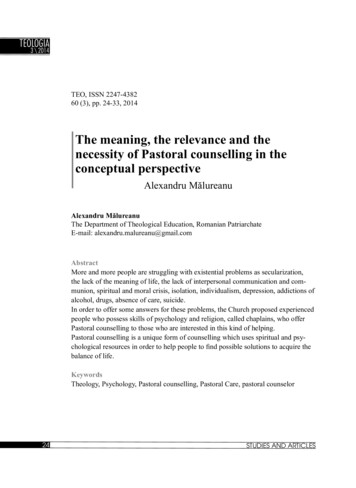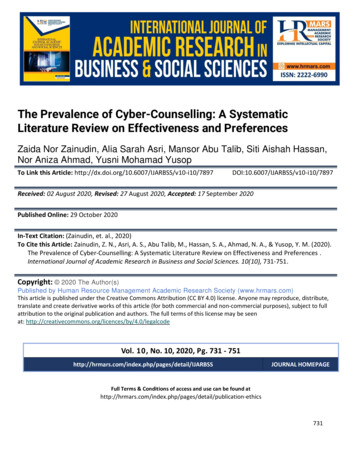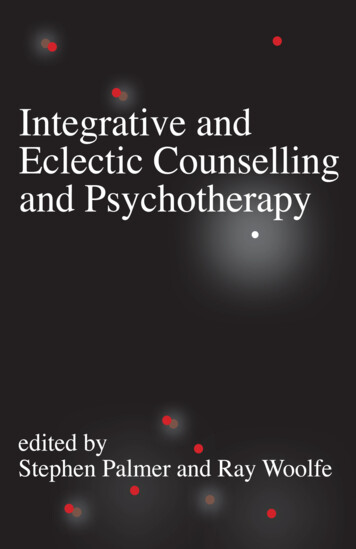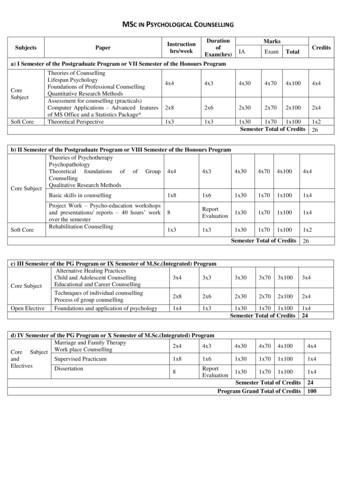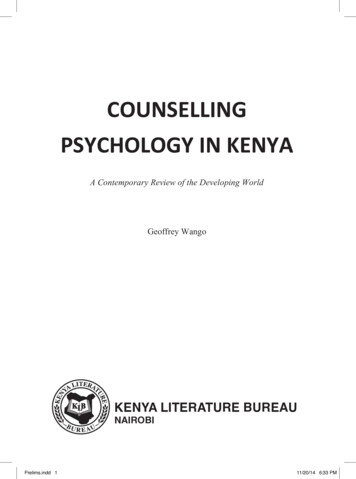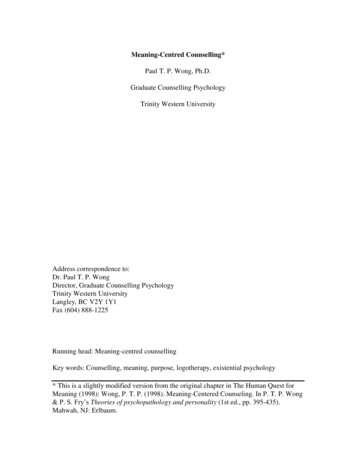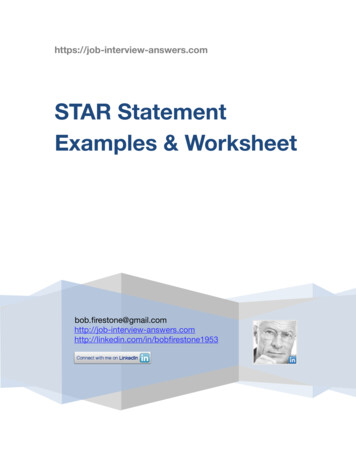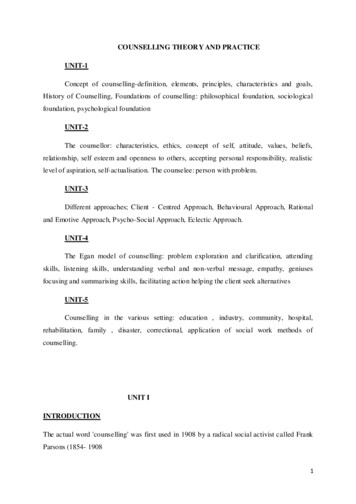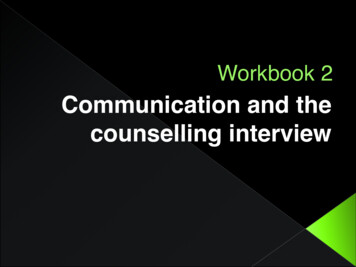
Transcription
Workbook 2Communication and thecounselling interview
The functions ofinterpersonal communication1. Through interpersonal communication we attemptto meet our social/psychological needs2. Through interpersonal communication we attemptto achieve goals3. Through interpersonal communication wedevelop a sense of self4. Through interpersonal communication we acquireinformation.5. Through interpersonal communication weinfluence and are influenced by others
Interpersonal communicationcomponents ContextPhysical contextSocial contextHistorical contextPsychological contextCultural contextMessage formationMeaningSymbolsEncoding and decodingChannelsNoiseInternal noiseSemantic noise
Ethics of interpersonalCommunication1. Ethical communicators are truthful andhonest2. Ethical communicators act with intergrity3. Ethical communicators behave fairly4. Ethical communicators demonstrate respectfor the ideas, opinion and feelings of others5. Ethical communicators are responsible.
The 12 barriers to communication:Judging1. Criticizing2. Name calling3. Diagnosing4. Praising evaluativelySending Solutions5. Ordering6. Threatening7. Moralizing8. Excessive/inappropriate questioning9. AdvisingAvoiding other’s concerns10. Diverting11. Logical argument12. Reassuring
All interviews use micro skills and strategiesand they often follow a sequence of statesfrom beginning to end:1. Initial the session – rapport and structure2. Gathering the data – drawing out stories,concerns, problems, or issues3. Mutual goal setting – what does the clientwant to happen?4. Working- exploring alternatives, confrontingclient incongruities and conflict re-storying.5. Terminating – generalising and acting onnew stories.
The communication processYourWhaIdeatWhayoutrytot youdayWhatactuthe– DISTRACTIONNOISE what s/
The importance of attention Attending to othersListenFocus on the clientQuieten your inner voiceInternal psychical blocksPhysical barriers to good listeningListening on the telephone
Awareness of body language Ways to communicate Non-Verbally››››› The face and facial expressionsEye contactBody movements and gesturesThe distance between two people talkingThe use of touchAwareness of your own bodyFacial expressionsEye contactBody movementDistance and touchFeedback within communicationSocial and cultural trends
tioningTechniquesSummaryReflectionClosedQuestions
Using verbal communication well The words – the tone of your voice, the rhyme of howyou speak and the volumeUse of language in helping – the longer you stay silentthe harder it becomes to interrupt the client’smonologueEncouraging sounds and words – ‘aha’ or ‘mmm’Paraphrasing and summarising – ‘you’re really upsetat the way you’re been treated’Open ended questionsA range of languages- keep your language simpleA positive approachThree way communication – use eye contact
Skills for identifying andclarifying problemsIdentifying and clarifying problems skillscontain elements of stepping outsideor going beyond clients internalviewpoints. These skills help clientselaborate and therefore more fullyunderstand their internal viewpoints.
Structuring skills Objectives of structuringtoo much or too little structureSame structuring skillsVerbal message skillsVoice and body messages
Types of questions Clarification questionsElaboration questionsChallenging questionsSpecific detail questionsRequest for example questionsEliciating personal meaning questionsAsk establishing agenda and tranisationquestionsIntersperse reflective responding withquestions
Ask follow on questionsEncourage clients to do their own workCarefully observe how questions are answeredUse good voice and body messages.Confronting skills- counsellors can useconfronting skills to challenge the following: Confronting inconsistenceConfronting possible distortions of realityConfronting by reframingConfronting not acknowledging
How to confront1.2.3.4.5.6.7.Start with reflective respondingWhere possible help client to confront themselvesDo not talk downUse a minimum amount of muscleAvoid threatening voice and body messagesLeave the ultimate responsibility with the clientsDo not over do it
Intentional listening1.2.3.4.5.Minimal responseBrief invitation to continueNon-verbal behaviourVoiceSilence
Reflection of feelings“It seems to me that clients who have movedsignificantly in therapy live more intimatelywith their feelings of pain, but also morevividly with their feeling of ecstasy; that angeris more clearly felt, but so also is love; thatfear is an experience they know more deeply,but so is courage”Carl Rogers
Why use reflection of feelings?Often we ignore, deny, distort or repress ourfeelings because we have been tod that they areunacceptable. We need to return to out emotionsand allow ourselves to feel them because onlythen can we decide what we want to do aboutthem.Examples include:‘You feel angry at your partner for not taking careof your children;‘You seem pleased that your told your boss thatyou didn’t want to work late’
Benefits of reflection of feelings: are idealinterventions for enabling clients to enter intotheir internal experiences, especially if theyare delivered with concern and empathyHow reflection of feelings relates to empathy:some authors have equated reflection offeeling to empathy. We disagree wit thisstance; we believe that it is too narrow todefine empathy as just a reflection of feeling
Caveats: sharing feelings has positivebenefits in that clients can experience relieffrom tension, come to accept their feelingsand feel proud that they had the courage toexpress and face their feelings.How to reflect feelings: Format of reflection of feelings Identifying feeling words Sources of reflection Client’s expression of feeling
Thank you for watchingthis video and goodluck with workbook 2.Bye for now !
Using verbal communication well The words - the tone of your voice, the rhyme of how you speak and the volume Use of language in helping - the longer you stay silent the harder it becomes to interrupt the client's monologue Encouraging sounds and words - 'aha' or 'mmm' Paraphrasing and summarising - 'you're really upset


